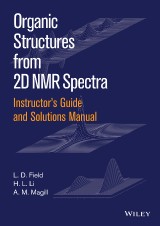Details

Instructor's Guide and Solutions Manual to Organic Structures from 2D NMR Spectra, Instructor's Guide and Solutions Manual
1. Aufl.
|
23,99 € |
|
| Verlag: | Wiley |
| Format: | |
| Veröffentl.: | 30.03.2015 |
| ISBN/EAN: | 9781119027263 |
| Sprache: | englisch |
| Anzahl Seiten: | 400 |
DRM-geschütztes eBook, Sie benötigen z.B. Adobe Digital Editions und eine Adobe ID zum Lesen.
Beschreibungen
The text Organic Structures from 2D NMR Spectra contains a graded set of structural problems employing 2D-NMR spectroscopy. The Instructors Guide and Solutions Manual to Organic Structures from 2D NMR Spectra is a set of step-by-step worked solutions to every problem in Organic Structures from 2D NMR Spectra. While it is absolutely clear that there are many ways to get to the correct solution of any of the problems, the instructors guide contains at least one complete pathway to every one of the questions. In addition, the instructors guide carefully rationalises every peak in every spectrum in relation to the correct structure. The Instructors Guide and Solutions Manual to Organic Structures from 2D NMR Spectra: Is a complete set of worked solutions to the problems contained in Organic Structures from 2D NMR Spectra. Provides a step-by-step description of the process to derive structures from spectra as well as annotated 2D spectra indicating the origin of every cross peak. Highlights common artefacts and re-enforces the important characteristics of the most common techniques 2D NMR techniques including COSY, NOESY, HMBC, TOCSY, CH-Correlation and multiplicity-edited C-H Correlation. This guide is an essential aid to those teachers, lecturers and instructors who use Organic Structures from 2D NMR as a text to teach students of Chemistry, Pharmacy, Biochemistry and those taking courses in Organic Chemistry.
<p>Preface ix</p> <p>Solutions Summary 1</p> <p>Problem 1 (1-iodopropane) 7</p> <p>Problem 2 (2-butanone) 11</p> <p>Problem 3 (2-hexanone) 15</p> <p>Problem 4 (ethyl propionate) 19</p> <p>Problem 5 (ethyl 3-ethoxypropionate) 23</p> <p>Problem 6 (4-acetylbutyric acid) 28</p> <p>Problem 7 (3-ethoxypropionyl chloride) 32</p> <p>Problem 8 (ethyl 3-chloropropionate) 36</p> <p>Problem 9 (isoamyl acetate) 40</p> <p>Problem 10 (trans-4-hexen-3-one) 45</p> <p>Problem 11 (trans-2-octen-4-one) 50</p> <p>Problem 12 (3-nitrobenzaldehyde) 55</p> <p>Problem 13 (3-iodotoluene) 61</p> <p>Problem 14 (8-hydroxy-5-nitroquinoline) 64</p> <p>Problem 15 (2-bromo-3-picoline) 69</p> <p>Problem 16 (trans-anethole) 72</p> <p>Problem 17 (cis-2-pentene) 75</p> <p>Problem 18 (p-tolyl benzoate) 79</p> <p>Problem 19 (phenyl p-toluate) 86</p> <p>Problem 20 (4-biphenylyl acetate) 93</p> <p>Problem 21 (4 ′ -phenoxyacetophenone) 99</p> <p>Problem 22 (4 ′ -tert-butylacetophenone) 106</p> <p>Problem 23 (2,2,4 ′ -trimethylpropiophenone) 110</p> <p>Problem 24 (trans-2-methyl-3-phenyl-2-propen-1-ol) 114</p> <p>Problem 25 (methyl 4-ethoxybenzoate) 119</p> <p>Problem 26 (methyl 3-(p-tolyl)propionate) 123</p> <p>Problem 27 (4-(4 ′ -methoxyphenyl)-2-butanone) 127</p> <p>Problem 28 (ethyl 6-bromohexanoate) 132</p> <p>Problem 29 (piperonal) 135</p> <p>Problem 30 (cis-3-hexenyl benzoate) 139</p> <p>Problem 31 (trans-2,cis-6-nonadienal) 146</p> <p>Problem 32 (allyl glycidyl ether) 155</p> <p>Problem 33 (3,4-epoxy-4-methyl-2-pentanone) 159</p> <p>Problem 34 (dl-methionine) 162</p> <p>Problem 35 (N-acetyl-l-leucine) 165</p> <p>Problem 36 (isoamyl valerate) 170</p> <p>Problem 37 ((E)-4-methyl-4 ′ -nitrostilbene) 173</p> <p>Problem 38 (2-tert-butyl-6-methylphenol) 181</p> <p>Problem 39 (2-allyl-6-methylphenol) 186</p> <p>Problem 40 (2-hydroxy-4-methoxybenzaldehyde) 194</p> <p>Problem 41 (2 ′ -hydroxy-5 ′ -methylacetophenone) 198</p> <p>Problem 42 (3 ′ -fluoro-4 ′ -methoxyacetophenone) 203</p> <p>Problem 43 (trans-ferulic acid) 209</p> <p>Problem 44 (sec-butyl 3-hydroxycinnamate) 215</p> <p>Problem 45 (1-benzosuberone) 221</p> <p>Problem 46 (dimethyl (3-bromopropyl)phosphonate) 228</p> <p>Problem 47 (caffeine) 233</p> <p>Problem 48 (benzyloxypropionitrile) 238</p> <p>Problem 49 (cineole) 242</p> <p>Problem 50 (thymoquinone) 246</p> <p>Problem 51 (4-bromo-1-indanol) 251</p> <p>Problem 52 (1-bromo-4-methylnaphthalene) 257</p> <p>Problem 53 (carvacrol) 264</p> <p>Problem 54 (acetoacetanilide) 272</p> <p>Problem 55 (ethyl acetamidocyanoacetate) 277</p> <p>Problem 56 (α-humulene) 283</p> <p>Problem 57 (3,4-dihydro-2H-benzopyran-3-carboxylic acid) 289</p> <p>Problem 58 (quinidine) 296</p> <p>Problem 59 (salbutamol) 312</p> <p>Problem 60 (2-hydroxy-1-naphthaldehyde) 322</p> <p>Problem 61 (6-methyl-4-chromanone) 329</p> <p>Problem 62 (citronellal) 336</p> <p>Problem 63 ((+)-cis-2-oxabicyclo-[3.3.0]oct-6-en-3-one) 344</p> <p>Problem 64 (melatonin) 349</p> <p>Problem 65 (carvone) 362</p> <p>Problem 66 (haloperidol) 370</p>
<p>L. D. Field is the author of Instructor's Guide and Solutions Manual to Organic Structures from 2D NMR Spectra, published by Wiley. A. M. Magill is the author of Instructor's Guide and Solutions Manual to Organic Structures from 2D NMR Spectra, published by Wiley.
The text Organic Structures from 2D NMR Spectra contains a graded set of structural problems employing 2D-NMR spectroscopy. The Instructors Guide and Solutions Manual to Organic Structures from 2D NMR Spectra is a set of step-by-step worked solutions to every problem in Organic Structures from 2D NMR Spectra. While it is absolutely clear that there are many ways to get to the correct solution of any of the problems, the instructors guide contains at least one complete pathway to every one of the questions. In addition, the instructors guide carefully rationalises every peak in every spectrum in relation to the correct structure. The Instructors Guide and Solutions Manual to Organic Structures from 2D NMR Spectra: Is a complete set of worked solutions to the problems contained in Organic Structures from 2D NMR Spectra. Provides a step-by-step description of the process to derive structures from spectra as well as annotated 2D spectra indicating the origin of every cross peak. Highlights common artefacts and re-enforces the important characteristics of the most common techniques 2D NMR techniques including COSY, NOESY, HMBC, TOCSY, CH-Correlation and multiplicity-edited C-H Correlation. This guide is an essential aid to those teachers, lecturers and instructors who use Organic Structures from 2D NMR as a text to teach students of Chemistry, Pharmacy, Biochemistry and those taking courses in Organic Chemistry.


















